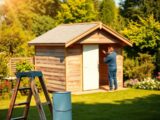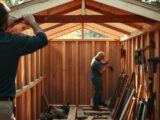How to Heat Your Shed, Log Cabin or Summerhouse
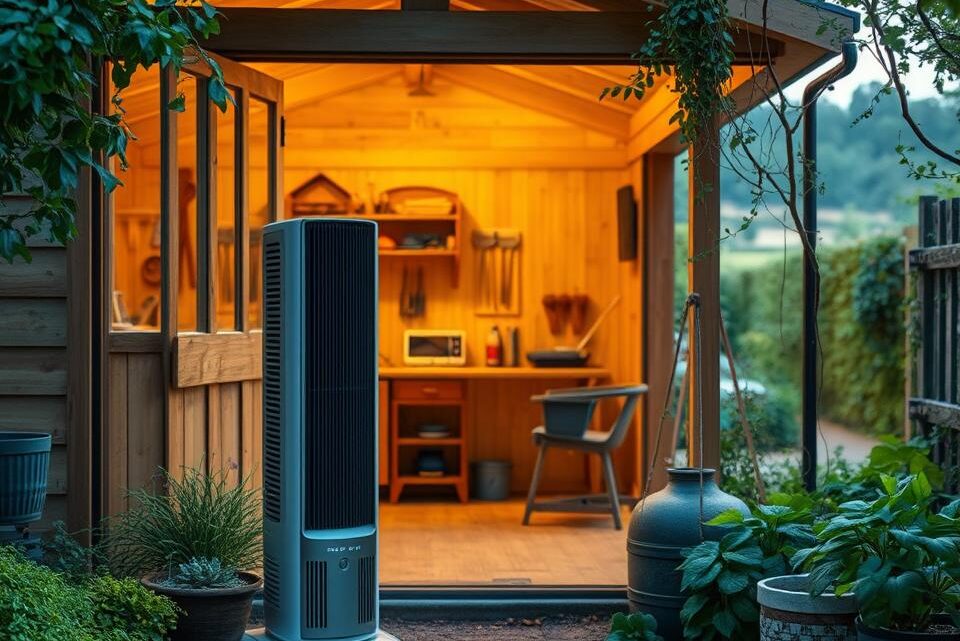
Garden buildings like sheds, log cabins, and summerhouses offer versatile spaces for relaxation, work, and storage. Effective outdoor structure heating is crucial for maintaining comfort and protecting your valuable investment throughout the year.
Transforming these external spaces into functional areas requires strategic garden building heating solutions. Whether you use your structure as a home office, workshop, or retreat, understanding proper heating techniques can extend its usability during colder months.
Selecting the right heating method depends on multiple factors, including space size, insulation quality, and intended usage. Each outdoor structure presents unique challenges that demand tailored heating approaches to ensure optimal warmth and efficiency.
Inhaltsverzeichnis
Key Takeaways
- Understand the importance of proper heating for garden buildings
- Explore diverse heating solutions for outdoor structures
- Consider insulation as a critical factor in heating effectiveness
- Evaluate different energy sources for garden building heating
- Prioritise safety when implementing heating systems
Understanding the Importance of Proper Heating for Outdoor Structures
Garden buildings have transformed from simple storage spaces to versatile retreats that extend living areas beyond traditional home boundaries. Effective outdoor structure temperature control is crucial for maximising the functionality and comfort of these cherished spaces.
The strategic approach to garden building insulation goes far beyond mere temperature management. It represents a comprehensive strategy to protect, preserve, and enhance your outdoor structure’s utility throughout the year.
Benefits of a Well-Heated Garden Building
- Extends usable space during colder months
- Increases property value
- Creates comfortable workspace or relaxation area
- Prevents structural damage from moisture and cold
Health and Safety Considerations
Proper heating prevents critical health risks associated with damp and cold environments. Consistent temperature control helps mitigate potential respiratory issues by reducing condensation and mould growth.
| Temperature Range | Health Impact | Recommended Action |
|---|---|---|
| Below 10°C | High risk of dampness | Install heating system |
| 10-15°C | Moderate condensation risk | Use dehumidifier |
| Above 15°C | Optimal comfort zone | Maintain consistent heating |
Protection of Contents and Structure
Garden building insulation acts as a critical shield against temperature fluctuations. By maintaining stable internal conditions, you protect valuable equipment, furniture, and the structural integrity of your outdoor building from potential weather-related damage.
Investing in proper heating is not an expense, but a long-term preservation strategy for your garden structure.
Assessing Your Space: Size, Insulation and Heat Requirements
Understanding your garden building’s heating needs starts with a comprehensive outdoor structure insulation assessment. Every garden room, shed, or log cabin has unique characteristics that influence its heat requirements.
Begin by measuring your space precisely. Accurate garden building heat calculation depends on several critical factors:
- Total floor area
- Ceiling height
- Window and door dimensions
- Current insulation quality
The size of your outdoor structure directly impacts heat distribution. Smaller spaces under 10 square metres might require less powerful heating solutions, while larger garden rooms demand more robust temperature management strategies.
Your local climate plays a significant role in determining heating requirements. Consider these key aspects during your outdoor structure insulation assessment:
- Average winter temperatures
- Wind exposure
- Building orientation
- Surrounding landscape features
Professional heating experts recommend conducting a thorough thermal evaluation before selecting any heating system. This approach ensures optimal energy efficiency and comfort in your garden building.
Different Types of Heating Solutions for Garden Buildings
Selecting the right heating solution for your shed, log cabin, or summerhouse is crucial for creating a comfortable and functional outdoor space. The variety of shed heating options available today can transform your garden building into a cosy retreat throughout the year.

Garden structures require careful consideration when choosing heating systems. The right log cabin heating systems can make a significant difference in usability and comfort.
Electric Heaters: Versatile Summerhouse Heating Solutions
Electric heaters offer flexible warming options for garden buildings. These summerhouse heating solutions come in various types:
- Fan heaters: Quick and portable
- Oil-filled radiators: Consistent and energy-efficient
- Infrared panels: Modern and sleek heating technology
Gas Heating: Powerful Warmth for Outdoor Spaces
Gas heating provides robust warmth for larger garden structures. Options include:
- Portable propane heaters
- Fixed natural gas systems
| Heating Type | Pros | Cons |
|---|---|---|
| Electric Heaters | Easy installation | Higher running costs |
| Gas Heaters | Powerful heat output | Requires professional installation |
Wood-Burning Solutions: Traditional Warmth
Wood-burning stoves offer a classic heating approach for garden buildings. They provide authentic warmth and create a charming atmosphere.
The right heating solution can transform your garden building from a seasonal space to a year-round retreat.
How to Heat Your Shed, Log Cabin or Summerhouse

Implementing an effective garden building heating setup requires careful planning and consideration. The right approach to outdoor structure heating installation can transform your garden building into a comfortable year-round space.
Before beginning your heating project, assess your specific needs. Different garden structures demand unique heating solutions:
- Evaluate the size of your garden building
- Check existing electrical or gas connections
- Determine primary usage of the space
- Consider insulation levels
Placement of heating units is critical for optimal performance. Electric heaters work best when positioned away from moisture sources, while gas heaters require proper ventilation. Wall-mounted options can save valuable floor space in smaller garden buildings.
Safety remains paramount during outdoor structure heating installation. Key precautions include:
- Ensuring electrical systems can handle additional load
- Maintaining clear space around heating units
- Installing carbon monoxide detectors for gas heaters
- Using weatherproof electrical connections
Professional installation might be necessary for complex garden building heating setups, especially when working with gas connections or extensive electrical modifications. DIY enthusiasts should carefully evaluate their technical skills before attempting intricate installations.
Always prioritise safety and consult experts when uncertain about your heating project’s technical requirements.
Essential Insulation Tips Before Installing Heating
Preparing your garden building for effective heating starts with robust insulation. Garden building insulation techniques are crucial for creating a comfortable and energy-efficient outdoor structure. Proper insulation not only keeps your space warm but also significantly reduces heating costs.
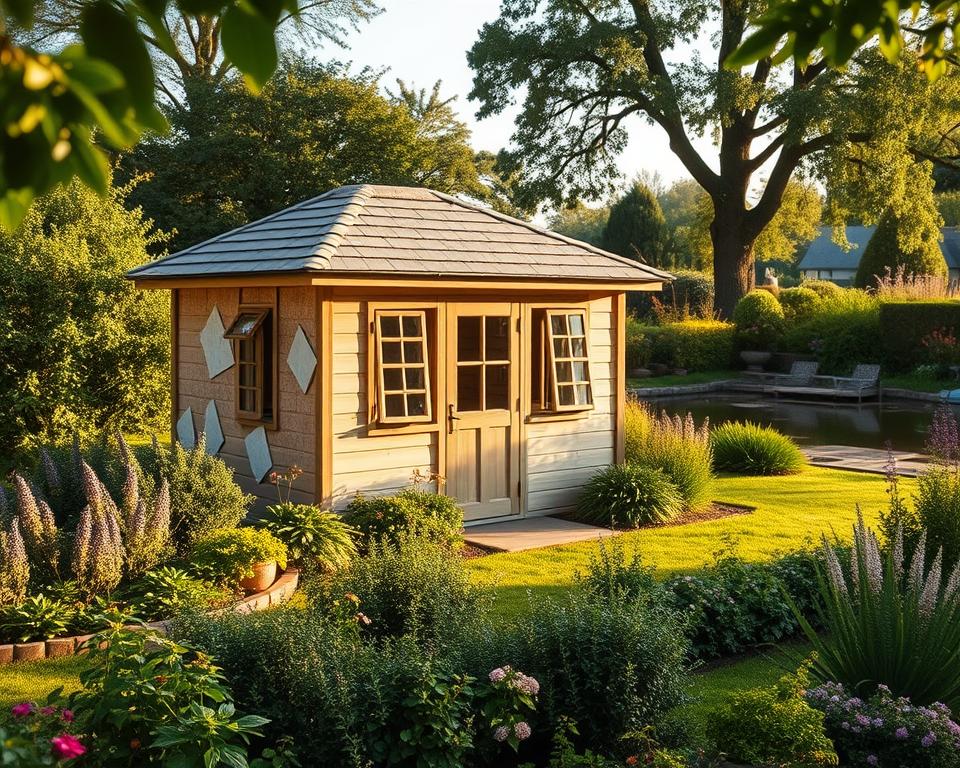
Effective outdoor structure draught-proofing is the first step in creating a thermal barrier. Gaps and cracks can dramatically reduce your heating efficiency, allowing precious warmth to escape and cold air to penetrate.
Wall Insulation Methods
Selecting the right wall insulation is critical for maintaining temperature. Consider these options:
- Fibreglass batts for affordable coverage
- Spray foam insulation for complete sealing
- Rigid foam boards for superior thermal resistance
- Natural wool insulation for eco-friendly solutions
Floor and Ceiling Insulation
Don’t overlook your floor and ceiling when implementing garden building insulation techniques. These areas are significant sources of heat loss:
- Install underfloor insulation boards
- Use reflective foil barriers
- Apply weatherproof sealants
- Consider raised flooring for additional protection
Draught-Proofing Techniques
Outdoor structure draught-proofing involves strategic sealing of potential air entry points. Key areas to address include:
- Window and door frames
- Electrical outlet gaps
- Roof and wall junctions
- Ventilation openings
Investing in quality insulation can reduce heating costs by up to 40% in garden buildings.
Electrical Requirements and Safety Considerations
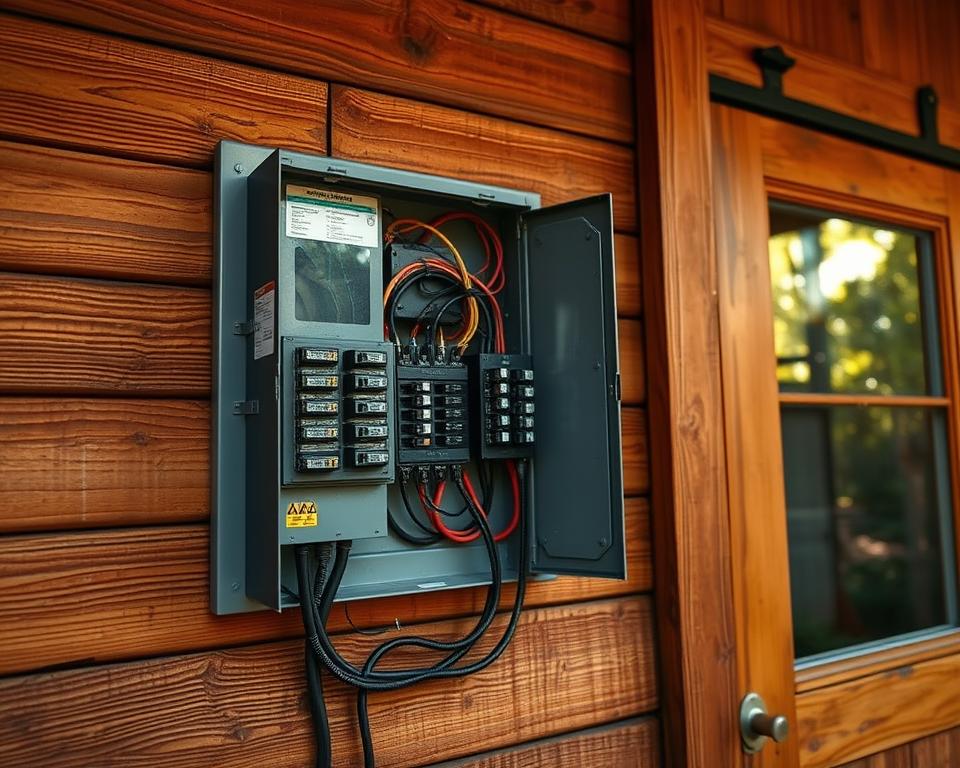
Electrical safety is paramount when setting up heating systems in garden buildings. Outdoor structure electrical safety demands careful planning and professional expertise to prevent potential hazards.
Garden building wiring requirements involve several critical considerations. Proper electrical installation protects both your structure and its occupants from potential risks.
- Ensure all electrical work complies with BS 7671 wiring regulations
- Use outdoor-rated electrical components specifically designed for external environments
- Install residual current devices (RCDs) for additional protection
- Maintain a minimum IP rating of IP44 for electrical equipment
Professional electricians play a crucial role in garden building electrical safety. They can:
- Assess your specific electrical load requirements
- Design appropriate circuit protection
- Install weatherproof electrical outlets
- Implement earthing and bonding systems
| Electrical Safety Feature | Purpose |
|---|---|
| RCD Protection | Prevents electrical shock by detecting current leakage |
| Outdoor-Rated Cables | Resists moisture and UV degradation |
| IP-Rated Sockets | Protects against water and dust ingress |
Remember: Electrical safety is not an area for DIY experimentation. Always consult a qualified electrician to ensure your garden building meets all necessary safety standards.
Cost-Effective Heating Methods and Energy Efficiency
Selecting the right heating solution for your garden building can significantly impact both comfort and energy expenses. Energy-efficient garden building heating isn’t just about staying warm—it’s about smart, strategic warmth that doesn’t break the bank.

Navigating the world of cost-effective outdoor structure heating requires careful consideration of several key factors. Your choice of heating system can make a substantial difference in long-term running costs and overall energy consumption.
Running Costs Comparison
Different heating methods come with varying operational expenses. Let’s break down the most common options:
- Electric Panel Heaters: Low initial cost, higher electricity consumption
- Infrared Heaters: Efficient spot heating, moderate running costs
- Gas Heaters: Higher installation expense, lower ongoing costs
- Wood-Burning Stoves: Initial investment, but cheaper fuel options
Energy-Saving Tips
Maximising your heating efficiency doesn’t have to be complicated. Consider these practical strategies:
- Install programmable thermostats
- Ensure proper insulation before heating
- Use draft excluders
- Opt for zone heating
Pro tip: Investing in quality insulation can reduce heating costs by up to 40% in garden buildings.
Maintenance and Upkeep of Heating Systems
Proper garden building heater maintenance is crucial for ensuring the longevity and efficiency of your outdoor structure heating system care. Regular upkeep not only extends the life of your heating equipment but also prevents unexpected breakdowns and maintains optimal performance.
Essential maintenance tasks vary depending on the type of heating system you have installed. Here are key steps to keep your garden building heater in top condition:
- Conduct monthly visual inspections of the heating unit
- Clean filters and heating elements every three months
- Check electrical connections for any signs of wear
- Inspect seals and insulation around the heating system
- Remove dust and debris from around the heating unit
Safety tip: Always disconnect the power supply before performing any maintenance tasks on your outdoor structure heating system.
Different heating solutions require specific care approaches:
- Electric heaters: Check power cords and plugs for damage
- Gas heaters: Ensure proper ventilation and check for gas leaks
- Wood-burning systems: Clean chimney and remove ash regularly
Professional servicing is recommended at least once a year. A qualified technician can perform comprehensive checks, identify potential issues, and ensure your garden building heating system operates at peak efficiency.
Regular maintenance can reduce energy consumption by up to 15% and prevent costly repairs.
By investing time in garden building heater maintenance, you’ll protect your outdoor structure, save money on potential repairs, and enjoy a reliable heating solution for years to come.
Common Heating Mistakes to Avoid
Heating an outdoor structure like a shed or log cabin requires careful planning. Many homeowners fall into common outdoor structure heating errors that can compromise safety and efficiency. Understanding these garden building heating pitfalls can save you from expensive mistakes and potential risks.
One critical error is neglecting proper insulation before installing heating systems. Without adequate insulation, heat escapes quickly, making your heating solution ineffective and costly. Owners often underestimate the importance of sealing gaps, weatherstripping, and ensuring proper thermal protection.
- Incorrect heater sizing for your space
- Inadequate ventilation around heating equipment
- Placing heaters near flammable materials
- Ignoring manufacturer’s safety guidelines
Another significant pitfall involves selecting inappropriate heating solutions. Not every heater suits every outdoor structure. Electric heaters might work perfectly in a well-insulated summerhouse, while gas options could be more suitable for larger log cabins with different ventilation requirements.
Safety should always be your primary concern. Many garden building owners overlook crucial safety measures, such as installing smoke detectors, keeping fire extinguishers nearby, and maintaining a clear area around heating appliances. These simple steps can prevent potential accidents and protect your valuable outdoor space.
Remember: A well-planned heating strategy prevents costly mistakes and ensures a comfortable, safe outdoor environment.
Conclusion
Transforming your garden building into a warm and inviting sanctuary requires thoughtful planning and smart heating solutions. Efficient garden building heating isn’t just about staying warm; it’s about creating a comfortable outdoor structure environment that extends your living space throughout the year.
Your journey to a perfectly heated shed, log cabin, or summerhouse involves careful consideration of insulation, heating options, and safety. From electric heaters to wood-burning stoves, the right choice depends on your specific needs, space, and budget. Remember that proper insulation is key to maintaining heat and reducing energy consumption.
Investing time and resources in understanding heating techniques will pay dividends. You’ll not only protect your outdoor structure from dampness and damage but also create a cosy retreat that can be enjoyed in every season. Whether you’re working, relaxing, or pursuing a hobby, a well-heated garden building offers endless possibilities.
Take action now. Assess your current setup, explore heating solutions, and make incremental improvements. With the right approach, you can transform your outdoor space into a comfortable, efficient, and welcoming environment that adds significant value to your home and lifestyle.
FAQ
What are the main benefits of heating my garden shed or log cabin?
Heating your outdoor structure offers multiple advantages, including extended usability throughout the year, protection of contents from dampness and cold, prevention of mould growth, and creating a comfortable space for work or relaxation. Proper heating can also help preserve the structural integrity of your building by preventing moisture-related damage.
How do I determine the right heating solution for my outdoor space?
The best heating solution depends on several factors, including the size of your structure, intended use, insulation levels, and local climate. Consider the space’s dimensions, current insulation, power availability, and your specific needs – whether it’s a workshop, home office, or leisure space. Electric heaters work well for smaller spaces, while gas or wood-burning options might suit larger or less-insulated buildings.
Is it expensive to heat a shed or log cabin?
Running costs vary depending on the heating method and insulation quality. Electric heaters can be cost-effective for small spaces, while gas and wood-burning options might be more economical for larger areas. Investing in good insulation can significantly reduce heating expenses by minimising heat loss and improving overall energy efficiency.
Do I need to insulate my outdoor structure before installing heating?
Absolutely! Insulation is crucial for effective heating. Proper insulation helps retain heat, reduces energy consumption, and prevents heat loss. Focus on insulating walls, floors, and ceilings, and seal any draught points. Good insulation can reduce heating costs by up to 50% and create a more comfortable environment.
What are the safety considerations for heating an outdoor building?
Safety is paramount when heating outdoor structures. Ensure proper ventilation, keep flammable materials away from heat sources, use appropriate electrical connections, and install smoke and carbon monoxide detectors. Always follow manufacturer guidelines, use certified heating equipment, and consider professional installation for complex heating systems.
Can I install heating in a wooden shed myself?
Some heating installations are suitable for DIY enthusiasts, such as plug-in electric heaters or simple wall-mounted units. However, complex installations involving gas connections or permanent electrical work should be completed by qualified professionals. Always prioritise safety and check local building regulations before undertaking any heating project.
What maintenance do heating systems in outdoor structures require?
Regular maintenance is essential for safe and efficient operation. This includes cleaning heating units, checking electrical connections, replacing filters, inspecting for wear and tear, and ensuring proper ventilation. Annual professional servicing is recommended for more complex heating systems like gas heaters or wood-burning stoves.
How can I make my outdoor heating more energy-efficient?
Improve energy efficiency by investing in good quality insulation, using programmable thermostats, selecting energy-efficient heating units, sealing draught points, and only heating the space when necessary. Consider smart heating controls that allow you to manage temperature remotely and reduce unnecessary energy consumption.
